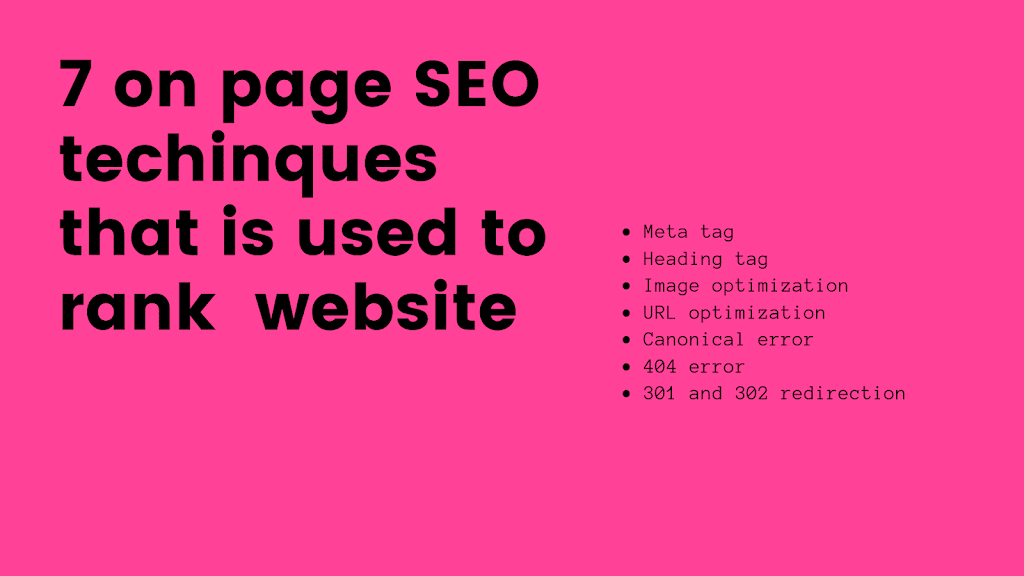On-page techniques that are used to rank on the website:
Before starting my points you must know about on-page SEO- let discuss about search engine optimization. This will help you define a better goal .
On-page SEO– It is the process of optimizing each and every page of your website. These include-
- Meta tag
- Heading tag
- Image optimization
- URL optimization
- Canonical error
- 404 error
- 301 and 302 redirection
Meta tag- The combination of title description and keyword is called the Meta tag.
The title should be 50-60 characters, description be 160 – 170 characters and keyword length should be 200 characters.
It describes the content of your website or web page.
Note- Your first 35 character is visible to your visitors
Your meta description is just below your meta title in the search engine.
Heading Tag– Heading tag is the HTML tag used to identify the heading and subheading of your content ( in paragraph text). There are 6 HTML tags.
H1 to H6:
While writing a context remember h1 to h6-
In H1 gives title one time and make sure that your content should be unique and user friendly.
- Break your paragraph 4 and 5 lines
- Bold italic understand your unique keyword
- H2 gives the title two times and follow the same procedure you follow in the H1 tag. But remember don’t copy content from another website.
- In h3 there is no restriction for title tag you give title much time as you wish.
- Use simple language which is easy to understand for users.
Image optimization– Image optimization means reducing the size of the image.
How to optimize image-
- Reducing image will help you in site speed.
- low image sends less HTTP request and high image sends more HTTP requests which is not good for the website.
- Remember the size of the image will be 300 kb. use an ALT tag to describe the image.
- Rename your download image
Tools used for image optimization:
- Compressor.io
- Tiny PNG
- Image recycle
- Gift of speed.PNG
URL optimization-URL stands for uniform resource locator. It is also called the response code. It simply means that it is the location address of the website and web page.
How to optimize URL-
- A domain that is very short
- Easy to remember
- Use an SSL certificate as much as possible but this is optional. But getting this certificate your website will be secure.
- Write your title as short as possible.
- TThe best way to optimize your website is to give categories to every page.
- Always use dash(-) and slash(/) in URL
- Add breadcrumb in your URL
- Do include a, an, and another word in the URL.
- Use only lower case character
Breadcrumb/slug– It is a small menu located at the top of the navigation aid. Using this method you decrease your page URL size.
Canonical error- The canonical error means that your website site has multiple URLs on a web page. Having different URLs of a website crawler does not have the potential for your website because you have duplicate content.
How to avoid canonical error problem-
- Proper use of the canonical tag in coding
- Don’t use duplicate content
- Use of 301 redirections when you move or delete a website and webpage
- Verify your account from google webmaster tool
404 error- 404 error is called response code-
404 error arises when –
When you move your website or web site page without redirection.
When you delete and rename your web page
Your website link is broken.
301 and 302 redirection –
301 redirection -301 redirection sends the message to the search engine that your website page is moved permanently.
If this redirection is not properly placed that you have a canonical issue.
This redirection is permanent in nature.
302 redirection– In this type of redirection search engines know that you move your web page or website.
These are temporary in nature.
Conclusion
Following this pattern is good for site ranking. But another factor is also responsible for ranking websites or web pages.
This is a basic factor to rank a website. Stay updated with search engine updates every time.
